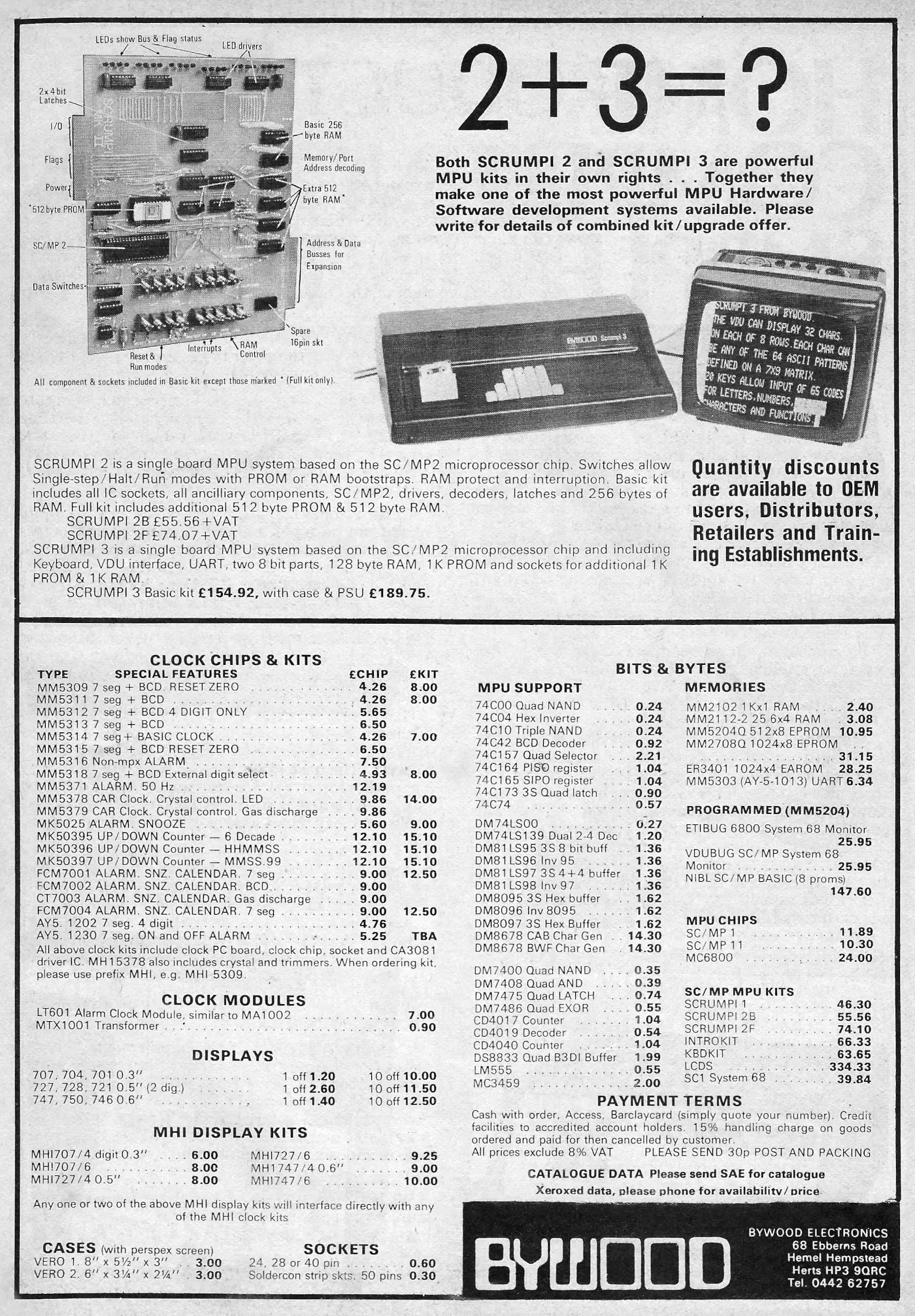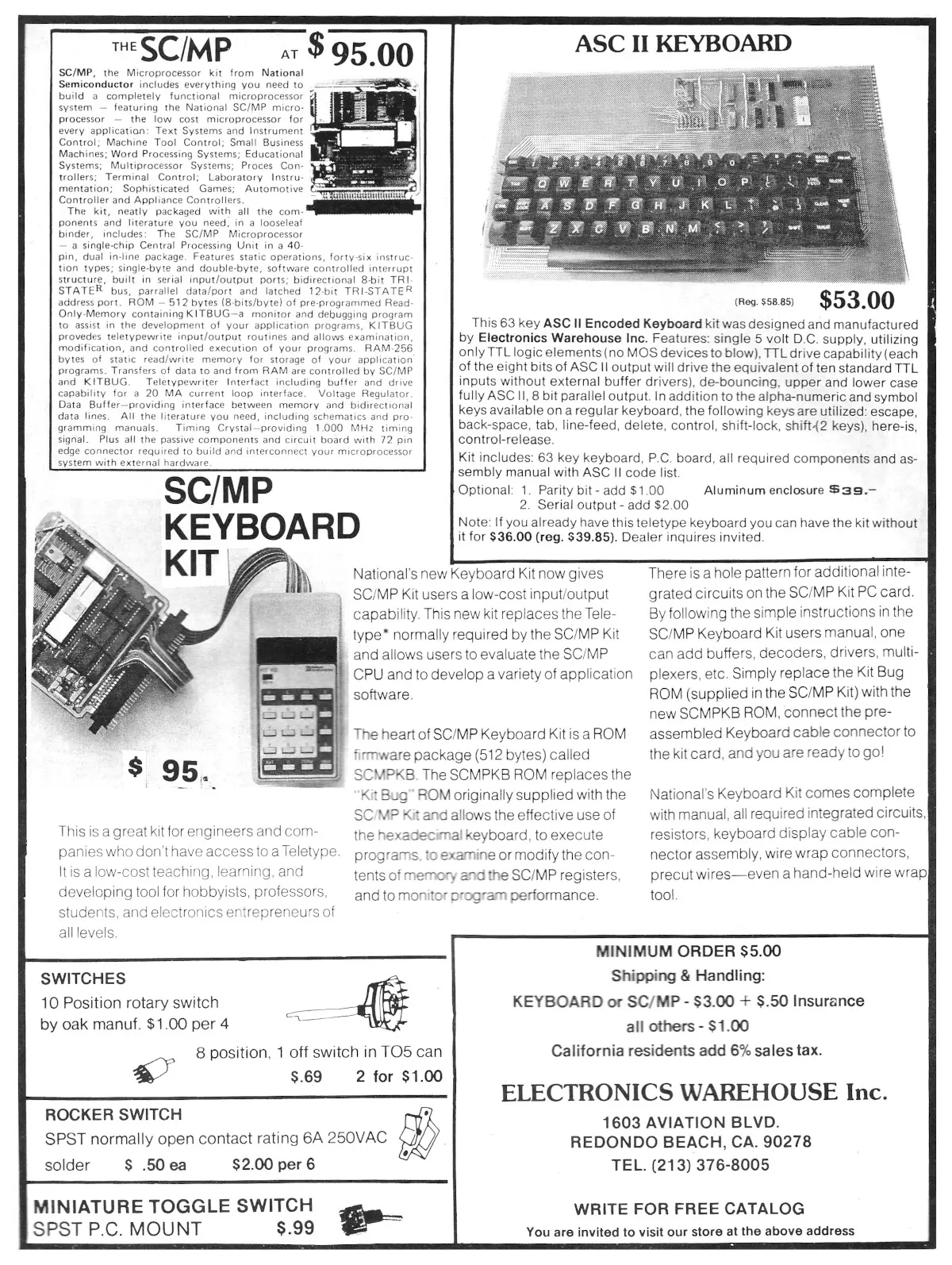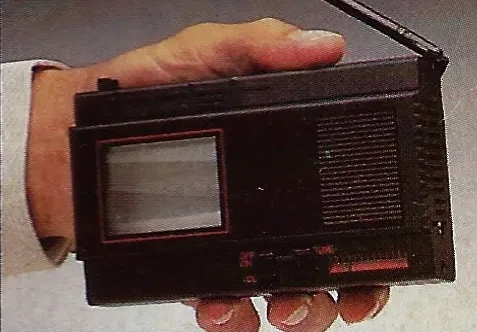
Bywood Advert - June 1978
From Electronics Today

Bywood SCRUMPI: 2 + 3 = ?
Had it not been for one of The Register's great articles[1] on one of the forgotten pioneers of the early computer scene, this advert from Bywood, a company founded in Hemel Hempstead, Hertfordshire, by John Miller-Kirkpatrick and which produced the UK's first kit computer, the Scrumpi 1 - launched at the end of 1976, over a year before Sinclair/Science of Cambridge's MK14 and even longer before Acorn's Microcomputer/System 1 - might have been overlooked.
This would have been a shame as the article suggests that Bywood might well have gone on to beat Sinclair at his own game had Miller-Kirkpatrick not died at the young age of 32, so it's worth an inclusion for both historical completeness and a glimpse of what might have been.
The updated Scrumpi 2 itself was relatively rudimentary, running National Semiconductors' SC/MP2 "Scamp" with the full kit including 512 bytes of PROM and 512 bytes of RAM - that's just enough memory to hold the first part of this entry up to about the word "Acorn".
The SC/MP processor was never widely used in the UK, with perhaps its only other appearance being in Sinclair's MK14. National did however also produce Acorn's much-delayed Gluon "superchip", the 16032 - later renamed to 32016 so it sounded more like the 32-bit chip it was.
Meanwhile, Brian Hewart, writing in September 1978's Personal Computer World wrote of it in comparison to its competitors, and in doing so explaining what SC/MP stood for, that:
"[The SC/MP] for some reason has always been looked down on but still has a strong following. Possibly National created the wrong image by promoting it as a Small Cost Micro Processor[2]".

An advert from April 1977's Byte - The Small Systems Journal magazine showing National Semiconductors' SC/MP "Scamp" microprocessor kit, as well as a keyboard kit for the same price of $95, or about £670 in 2025
Bywood's tiny one-board micro was however - in kit form at least - very cheap, with the original Scrumpi 1 clocking in at just £60 (around £460 in 2025 money).
The advert also references lots of Bywood's other product lines, which included not only various electronics components but also things like alarm clock modules and Bywood's first-ever computer, the SC1 System 68, available for just £43 (£330).
Elsewhere, in the June 1978 issue of Electronics Today international, the Scrumpi 3's price was compared to some of the other machines that were on the market, including the successful early UK computer the Nascom 1 - which under the section "extras required to get system going" has the entry "soldering iron" next to it.
Prices ranged from £145 (£1,120) for MOS Technology KIM-1 to a whopping £995 (£7,740) for the Apple II, beaten only in expense by Research Machines' 380Z at £1,063 (£8,270).
The Scrumpi 3 - the version which included a case, PSU and a video interface - was well down at the affordable end of the spectrum coming in at £189.75 (£1,470).

Sinclair's Pocket TV, from Popular Computing Weekly, June 1985About a year later, Miller-Kirkpatrick was featured in the first edition of Personal Computer World, after he'd managed to connect a Scrumpi to one of Clive Sinclair's Pocket TVs.
The combined system wasn't particularly light, but perhaps the most impressive thing was that Miller-Kirkpatrick had devised a way of generating display text that was actually big enough to view on the tiny screen.
Along with this, and in order to save money, the Scrumpi had a keyboard which came with only 16 keys. It used various shift-key combinations on order to generate the full character set, a bit like the way that the Sinclair had various key combinations in order to use its single-key BASIC.
Uncle Clive would have been proud[3].
Date created: 30 November 2013
Last updated: 18 September 2025
Hint: use left and right cursor keys to navigate between adverts.
Sources
Text and otherwise-uncredited photos © nosher.net 2025. Dollar/GBP conversions, where used, assume $1.50 to £1. "Now" prices are calculated dynamically using average RPI per year.